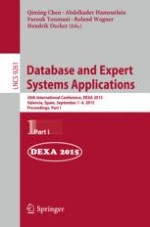This two volume set LNCS 9261 and LNCS 9262 constitutes the refereed proceedings of the 26th International Conference on Database and Expert Systems Applications, DEXA 2015, held in Valencia, Spain, September 1-4, 2015.
The 40 revised full papers presented together with 32 short papers, and 2 keynote talks, were carefully reviewed and selected from 125 submissions. The papers discuss a range of topics including: temporal, spatial and high dimensional databases; semantic Web and ontologies; modeling, linked open data; NoSQLm NewSQL, data integration; uncertain data and inconsistency tolerance; database system architecture; data mining, query processing and optimization; indexing and decision support systems; modeling, extraction, social networks; knowledge management and consistency; mobility, privacy and security; data streams, Web services; distributed, parallel and cloud databases; information retrieval; XML and semi-structured data; data partitioning, indexing; data mining, applications; WWW and databases; data management algorithms.
These volumes also include accepted papers of the 8th International Conference on Data Management in Cloud, Grid and P2P Systems, Globe 2015, held in Valencia, Spain, September 2, 2015. The 8 full papers presented were carefully reviewed and selected from 13 submissions. The papers discuss a range of topics including: MapReduce framework: load balancing, optimization and classification; security, data privacy and consistency; query rewriting and streaming.
